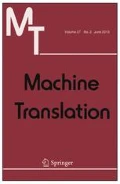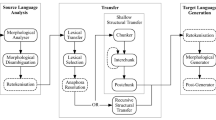Abstract
This paper gives a presentation of the E-framework, the formalism used in Eurotra for implementing the prototype translation system. In Section 1, we outline some of the underlying design principles and briefly discuss the evolutionary history of the Eurotra formalism, relating it to its predecessors and other recent unification-based formalisms. Section 2 introduces the reader to some central concepts and gives a comprehensive description of the core of the formalism.
Similar content being viewed by others
References
Arnold, D.J., S. Krauwer, M. Rosner, L. des Tombe and G.B. Varile. 1986. The <C,A>, T Framework in Eurotra: A Theoretically Committed Notation for MT. Proceedings of coling-86, Bonn, 297–303.
Arnold, D.J. and L. des Tombe. 1987. Basic Theory and Methodology in Eurotra. In S. Nirenburg (ed.), Machine Translation: Theoretical and Methodological Issues. Cambridge: Cambridge University Press, 114–135.
Arnold, D.J. and L. Sadler. 1989. MiMo: Theoretical Aspects of the System. Working papers in language processing, no. 6. Department of Language and Linguistics, University of Essex, UK.
Arnold, D.J., S. Krauwer, L. des Tombe and L. Sadler. 1988. Relaxed Compositionality in Machine Translation. Proceedings of the Second International Conference on Theoretical and Methodological Issues in Machine Translation of Natural Languages, Carnegie Mellon University, Pittsburgh.
Bech, A. and A. Nygaard. 1988. The E-Framework: A Formalism for Natural Language Processing. Proceedings of coling-88, Budapest, 36–39.
Damas, L. and G.B. Varile. Forthcoming. CLG: A Grammar Formalism Based on Constraint Resolution. Proceedings of epai-89.
Gazdar, G., E. Klein, G.K. Pullum and I. Sag. 1985. Generalized Phrase Structure Grammar. Oxford: Basil Blackwell.
Halvorsen, P. and R. Kaplan. 1988. Projections and Semantic Descriptions in Lexical Functional Grammar. Proceedings of fgcs-88, Tokyo.
Hauenschild, C. and S. Busemann. 1988. A Construtive Version of GPSG for Machine Translation. In E. Steiner, P. Schmidt and C. Zelinsky-Wibbelt (eds.), From Syntax to Semantics: Insights from Machine Translation. London: Francis Pinter, 216–236.
Johnson, R.L., S. Krauwer, M.A. Rosner and G.B. Varile. 1984. The Design of the Kernel Architecture for the Eurotra Software. Proceedings of coling-84, Stanford University, Stanford, 226–235.
Kaplan, R. and J. Bresnan. 1982. Lexical Functional Grammar: A Formal System for Grammatical Representation. In J. Bresnan (ed.), The Mental Representation of Grammatical Relations. Cambridge, Mass.: MIT Press, 173–282.
Kaplan, R., K. Netter, J. Wedekind and A. Zaenen. 1989. Translation by Structural Correspondences. Proceedings of eacl-89, Manchester, 272–282.
Kay, M. 1984. Functional Unification Grammar: A Formalism for Machine Translation. Proceedings of coling-84. Stanford University, Stanford, 75–79.
McCord, M.C. 1980. Slot Grammars. Computational Linguistics 6:31–43.
McCord, M.C. 1986. Design of a Prolog-based Machine Translation System. Proceedings of the Third International Logic Programming Conference. Berlin: Springer Verlag, 350–374.
McCord, M.C. 1989. Design of LMT: A Prolog-based Machine Translation System. Computational Linguistics 15:33–52. (IBM Research Report RC 13536, Yorktown Heights, N.Y.)
Pollard, C. and I. Sag. 1987. Information-based Syntax and Semantics. Vol. 1. Stanford: CSLI.
Sharp, R. 1988. CAT-2—Implementing a Formalism for Multi-Lingual Machine Translation. Proceedings of the second International Conference on Theoretical and Methodological Issues in Machine Translation of Natural Languages, Carnegie Mellon University, Pittsburgh.
Shieber, S., H. Uszkoreit, F. Pereira, J. Robinson and M. Tyson. 1983. The Formalism and Implementation of part-II. In B. Grosz and M. Stickel (eds.), Research and the Use of Knowledge, SRI Report, Menlo Park, Calif.
Shieber, S. 1986. An Introduction to Unification-based Approaches to Grammar. Stanford: CSLI.
Shieber, S. 1987. Separating Linguistic Analyses from Linguistic Theories. In P. Whitelock, M.M. Wood, H.L. Somers, R. Johnson and P. Bennett (eds.), Linguistic Theory and Computer Applications. Orlando: Academic Press, 1–37.
Shieber, S., 1989. cl-patr Reference Manual. SRI Technical Note 456, Menlo Park, Calif.
Author information
Authors and Affiliations
Additional information
The work described in this paper was carried out as a joint effort by the Framework Engineering Group in Eurotra in 1987 and 1988. Membership of the group has fluctuated, but apart from the authors the following persons have at one time or another contributed to the work: David Haines, Peter Lau, Jeremy Lindop, Dieter Maas, Giovanni Malnati, Archie Michiels, Carsten Kruse Olsson, Sergei Perschke, Tony Raw, Jörg Schütz, Randall Sharp, Giovanni B. Varile.
Of course, responsibility for the presentation in this article rests entirely with the authors.
Rights and permissions
About this article
Cite this article
Bech, A., Maegaard, B. & Nygaard, A. The Eurotra MT formalism. Mach Translat 6, 83–101 (1991). https://doi.org/10.1007/BF00417679
Issue Date:
DOI: https://doi.org/10.1007/BF00417679




